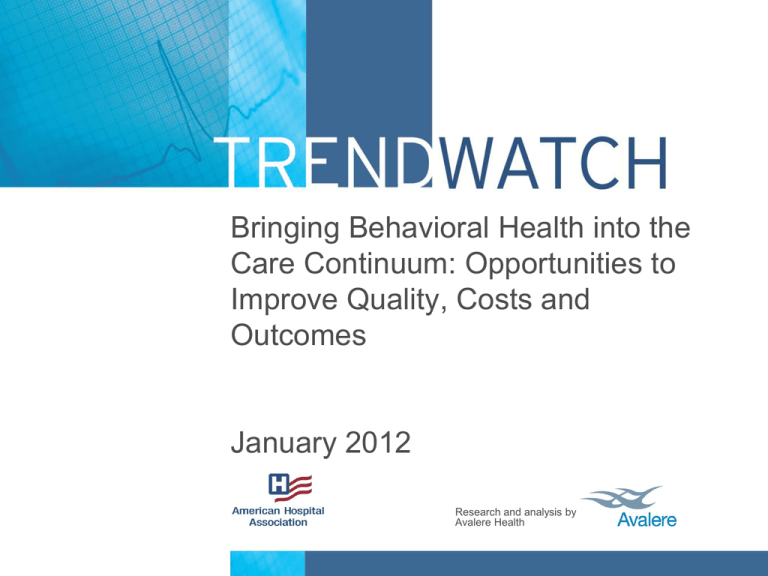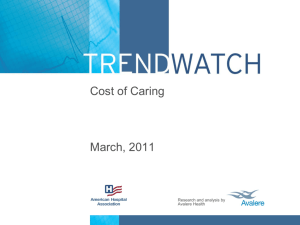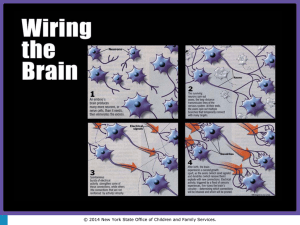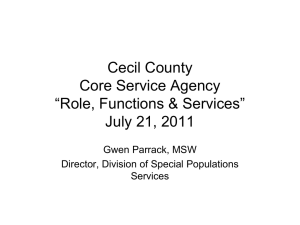Chartpack (pptx) - American Hospital Association
advertisement

Bringing Behavioral Health into the Care Continuum: Opportunities to Improve Quality, Costs and Outcomes January 2012 Research and analysis by Avalere Health Behavioral health conditions are prevalent among adults in the U.S. Chart 1: Percent of U.S. Adults Meeting Diagnostic Behavioral Health Criteria, 2007 57% Within Past 12 Months 35% 32% 31% Ever in Lifetime 25% 21% 19% 13% 10% Anxiety Disorder Mood Disorder 11% Impulse-control Disorder Substance Disorder Any Disorder Note: Anxiety disorder includes panic disorder, agoraphobia, specific phobia, social phobia, generalized anxiety disorder, post-traumatic stress disorder, obsessive compulsive disorder, and adult separation anxiety disorder. Impulse-control disorder includes oppositional defiant disorder, conduct disorder, attention deficit/hyperactivity disorder, and intermittent explosive disorder. Substance disorder includes alcohol abuse, drug abuse, and nicotine dependence. Source: Kaiser Commission on Medicaid and the Uninsured. (April 2011). Mental Health Financing in the United Research and analysis by Avalere Health States: A Primer. Washington, DC. Individuals with behavioral health conditions frequently have co-occurring physical health conditions. Chart 2: Percentage of Adults with Mental Health Conditions and/or Medical Conditions, 2001-2003 Adults with Mental Health Conditions Adults with Medical Conditions 29% of Adults with Medical Conditions Also Have Mental Health Conditions 68% of Adults with Mental Health Conditions Also Have Medical Conditions Source: Druss, B.G., and Walker, E.R. (February 2011). Mental Disorders and Medical Comorbidity. Research Synthesis Report No. 21. Princeton, NJ: The Robert Wood Johnson Foundation. Research and analysis by Avalere Health The presence of a mental health disorder raises treatment costs for chronic medical conditions. Chart 3: Monthly Health Care Expenditures for Chronic Conditions, with and without Comorbid Depression, 2005 Without Depression $1,420 With Depression $1,290 $840 $860 $130 $20 Mental Health Expenditures Medical Expenditures Total Expenditures Source: Melek, S., and Norris, D. (2008). Chronic Conditions and Comorbid Psychological Disorders. Cited in: Druss, B.G., and Walker, E.R. (February 2011). Mental Disorders and Medical Comorbidity. Research Synthesis Report No. 21. Princeton, NJ: The Robert Wood Johnson Foundation. Research and analysis by Avalere Health Cost is a common barrier to receiving mental health care services. Chart 4: Reasons for Not Receiving Mental Health Services, Among Adults Reporting Unmet Need, 2009 Could Not Afford Cost 45.7% Could Handle Problem Without Treatment at Time 26.6% Did Not Have Time 16.3% Did Not Know Where to Go For Services Health Insurance Did Not Cover Enough Treatment Treatment Would Not Help 15.3% 11.7% 10.6% Concerned About Confidentiality 9.3% Did Not Feel Need for Treatment 9.1% Might Cause Others to Have Negative Opinion 9.0% Might Have Negative Effect on Job 7.9% Note: Excludes those who reported unmet need but received some services. Source: Kaiser Commission on Medicaid and the Uninsured. (April 2011). Mental Health Financing in the United States: A Primer. Washington, DC. Research and analysis by Avalere Health The health care system’s capacity to deliver mental health services has been shrinking. Chart 5: Total Number of Psychiatric Units(1) in U.S. Hospitals and Total Number of Freestanding Psychiatric Hospitals(2) in U.S., 1995-2010 1,550 700 650 1,500 Psychiatric Units 550 1,400 500 Psychiatric Hospitals 450 1,350 400 1,300 Psychiatric Units 350 1,250 300 1,200 250 1995 1996 1997 1998 1999 2000 2001 2002 2003 2004 2005 2006 2007 2008 2009 2010 Note: Includes all registered and non-registered hospitals in the U.S. (1) Hospitals with a psychiatric unit are registered community hospitals that reported having a hospital-based inpatient psychiatric care unit for that year. (2) Freestanding psychiatric hospitals also include children‘s psychiatric hospitals and alcoholism/chemical dependency hospitals. Research and analysis by Avalere Health Source: Health Forum, AHA Annual Survey of Hospitals, 1995-2010. Psychiatric Hospitals 600 1,450 Treatment for behavioral health problems is most frequently delivered on an outpatient basis. Chart 6: Types of Mental Health Services Used in Past Year, Among Adults Receiving Treatment, 2009 Combination of Inpatient, Outpatient and/or Rx, 4% Inpatient Only, 2% Outpatient Only, 13% Rx Only, 49% Outpatient and Rx, 32% Note: Excludes treatment for substance abuse disorders. Source: Kaiser Commission on Medicaid and the Uninsured. (April 2011). Mental Health Financing in the United States: A Primer. Washington, DC. Research and analysis by Avalere Health Increased utilization of prescription drugs and decreased reliance on inpatient services has shifted spending over time. Chart 7: Distribution of Mental Health Expenditures by Type of Service, 1986 and 2005 $32 B $113 B Prescription Drugs, 7% Prescription Drugs, 27% Residential*, 22% Residential, 14% Outpatient, 24% Outpatient, 33% Inpatient, 42% Inpatient, 19% 1986 2005 Note: Excludes spending on insurance administration. Data not adjusted for inflation. * Residential treatment includes spending in nursing home units of hospitals or in nursing homes affiliated with hospitals. Source: Substance Abuse and Mental Health Services Administration. (2011) . National Expenditures for Mental Health Services & Substance Abuse Treatment 1986 – 2005. Washington, DC. As cited in Kaiser Commission on Medicaid and the Uninsured. (April 2011). Mental Health Financing in the United States: A Research and analysis by Avalere Health Primer. Washington, DC. Integration of behavioral and physical health care can improve access to appropriate care. Chart 8: Receipt of Preventive Care Services in 12 Months among Patients with Serious Psychiatric Illness Receiving Integrated Care vs. Patients Receiving Usual Care 86% Medication Listed in Chart 64% Educated about Smoking 64% 85% 85% Blood Pressure Tested 66% 83% Educated about Nutrition 62% 53% 80% Cholesterol Screening 57% 71% Screened for Diabetes Received Flu Vaccine Usual Care 81% Educated about Exercise Integrated Care 46% 32% 12% Source: Druss, B., et al. (2001). Integrated Medical Care for Patients with Serious Psychiatric Illness. A Randomized Trial. Archives of General Psychiatry, 58, 861-868. Research and analysis by Avalere Health Coordination of care can reduce costs for individuals with behavioral health conditions. Chart 9: Total Costs at 1 and 2 Years for Patients with Serious and Persistent Mental Illnesses Receiving a Medical Care Management Intervention vs. Usual Care $8,934 $8,715 $6,840 $5,908 Intervention Usual Care Year 1 Year 2 Source: Druss, B.G., et al. (2011). Budget Impact and Sustainability of Medical Care Management for Persons with Serious Mental Illness. American Journal of Psychiatry, AiA, 1-8. Research and analysis by Avalere Health A substantial number of uninsured adults with mental health needs will gain coverage under health reform. Chart 10: Simulated Change in Coverage After Reform Among Adults with Probable Depression or Serious Psychological Distress Uninsured, 15.0% Uninsured, 36.7% Private Insurance, 49.3% Private Insurance, 39.2% Medicaid, 24.5% Medicaid, 12.8% Medicare, 11.2% Medicare, 11.2% Baseline Post-reform Note: Based on data for adults ages 18-64 in the 2004-2006 Medical Expenditure Panel Surveys. Source: Garfield, R., et al. (2011). The Impact of National Health Care Reform on Adults With Severe Mental Disorders. American Journal of Psychiatry, 168(5): 486-494. Research and analysis by Avalere Health








